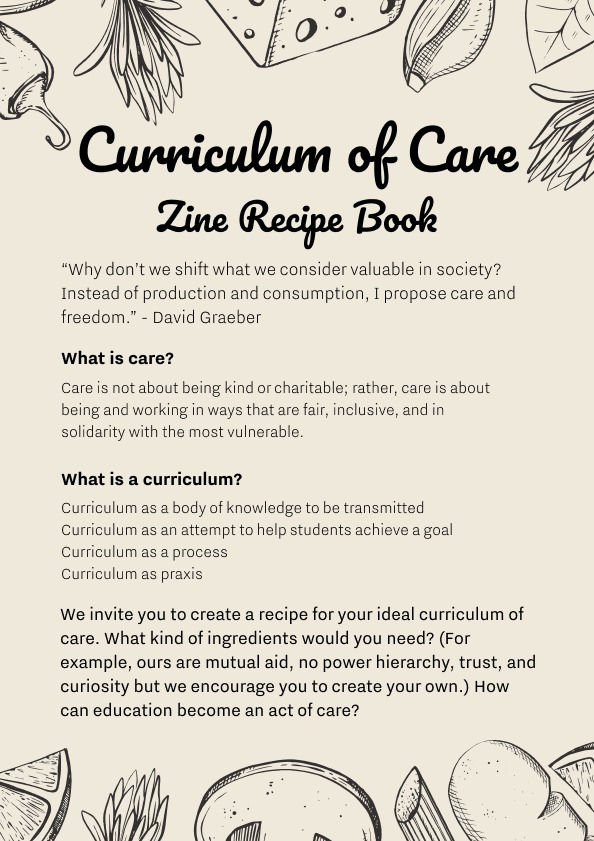Week 1: Visual Assembly
- vickisun4
- Jul 5, 2022
- 3 min read
Updated: Dec 17, 2023
Week 1
April 28 to May 6, 2022
Partners: Anya, Bipasha, Dany, Farah, Faiza, May, Sofia, Ziyuan, This Ain't Rock n Roll
Brief: Design and facilitate a Visual Assembly on the topic of The Curriculum of Care
First Steps
After receiving the brief, we decided to sit together and define key concepts to frame our project. We asked each other whether we wanted to split into smaller groups or work as a large group, and all of us decided that we wanted to stay together.
We wanted to incorporate the hand signals of the Visual Assembly into our meetings from the outset to recreate the democratic principles of the VA as closely as possible.

Our group decided to act like a people's assembly:
Use of hand signs
All voices are heard and valued equally
Voting on ideas
Defining Visual Assembly
Many of us had never heard of a visual assembly before, so we had to first ensure that we were on the same page with the event outcome. From the brief, we understood that a visual assembly is a participatory event that uses deliberative democracy techniques (facilitated group discussions) to tackle the crucial questions of our time.
Provocations vs. Solution-based Design
During our first meeting with Clive from This Ain't Rock n Roll, he stressed the importance of provocations for the Visual Assembly. Our job was to guide participants in the visual assembly to come up with their own curriculum of care, not to provide answers or solutions for them.

In a way, we were there as facilitators and designers of the event and process, rather than the final outcome.
Some examples of the provocations that we could begin with were:
Can students design their own courses?
Can the creation of university courses be a public shared event?
Can education become an act of care?
How can care have a pivotal role in education, what freedoms will this create?
Values of the VA
To help us design our provocations, we wanted to have a core set of values
The following quote from David Graeber served as a throughline for our Visual Assembly:
“Why don’t we shift what we consider valuable in society? Instead of production and = consumption, I propose care and freedom.”
We wanted to design for a curriculum that would shift from a transactional system of education to a political one.
We also took inspiration from Graeber's premise of a care class rather than a working class.
He said, "Feminists have long since pointed out that those on the bottom of any unequal social arrangement tend to think about, and therefore care about, those on top more than those on top think about, or care about, them."
His comments on nurses reimagining a hospital also served as a conceptual foundation for our values:
Concepts We Discussed:
We delved into other topics such as the following:
Participatory Democracy:
Participatory Budgeting in Brazil, empowers residents to directly decide how to spend part of a public budget
Legislative Theater: Theater of the Oppressed
Abolition and Prison Reform
Ex: Norway Prison, Community Care
Institutional barriers such as tuition fees
Museum of Care
Hospitality field + Open civic spaces (Libraries)
Visual Inspirations
We started to think about initial visual inspirations to guide us toward a final visual outcome. Elements we looked for were collectivity and minimalist but impactful visuals.
Lygia Pape's Divisor (1968), was striking both on visual and participatory levels. The performance art piece involved the participation of local schoolchildren in Rio de Janeiro.
In 1967, on the eve of the abolition of an already authoritarian constitution, Pape invited children from the favelas to walk the streets of Rio de Janeiro in a procession. The artist covered the children with a huge white cloth, the slits in which divided the crowd into single faces. As a "social sculpture," anyone could join the “carnival of the disenfranchised."
With Divisor, Pape wanted to create a collective work that could be repeated even when she was not present.

Next Steps
With our foundational research and conceptual grounding in hand, we went into the next week planning a manifesto of sorts in which we would define our values for the curriculum of care.
We thought about weaving and blankets in terms of visual outcomes.
We also wanted to think about the longevity of the visual assembly, such as how the Indignados managed to continue even after the initial Occupy Wall Street Movement.
References:
Joseph Beuys
David Graeber
Tuition Fees
TOMA
Occupy
Mutual Aid
Classroom Management as a Curriculum of Care
Clement Attlee
Lygia Pape
Visual Assembly
Extinction Rebellion
Museum of Care
Care Manifesto



Comments